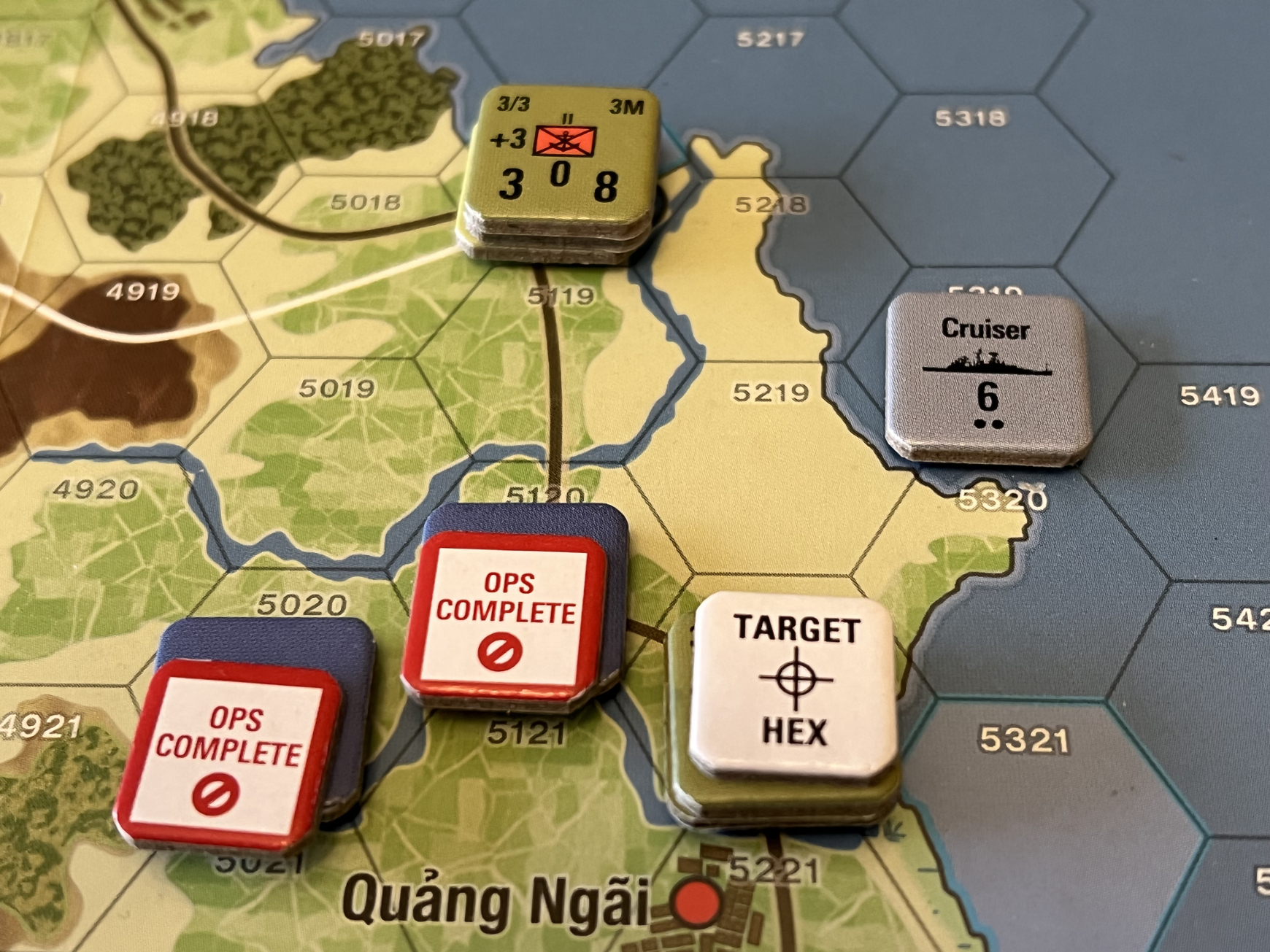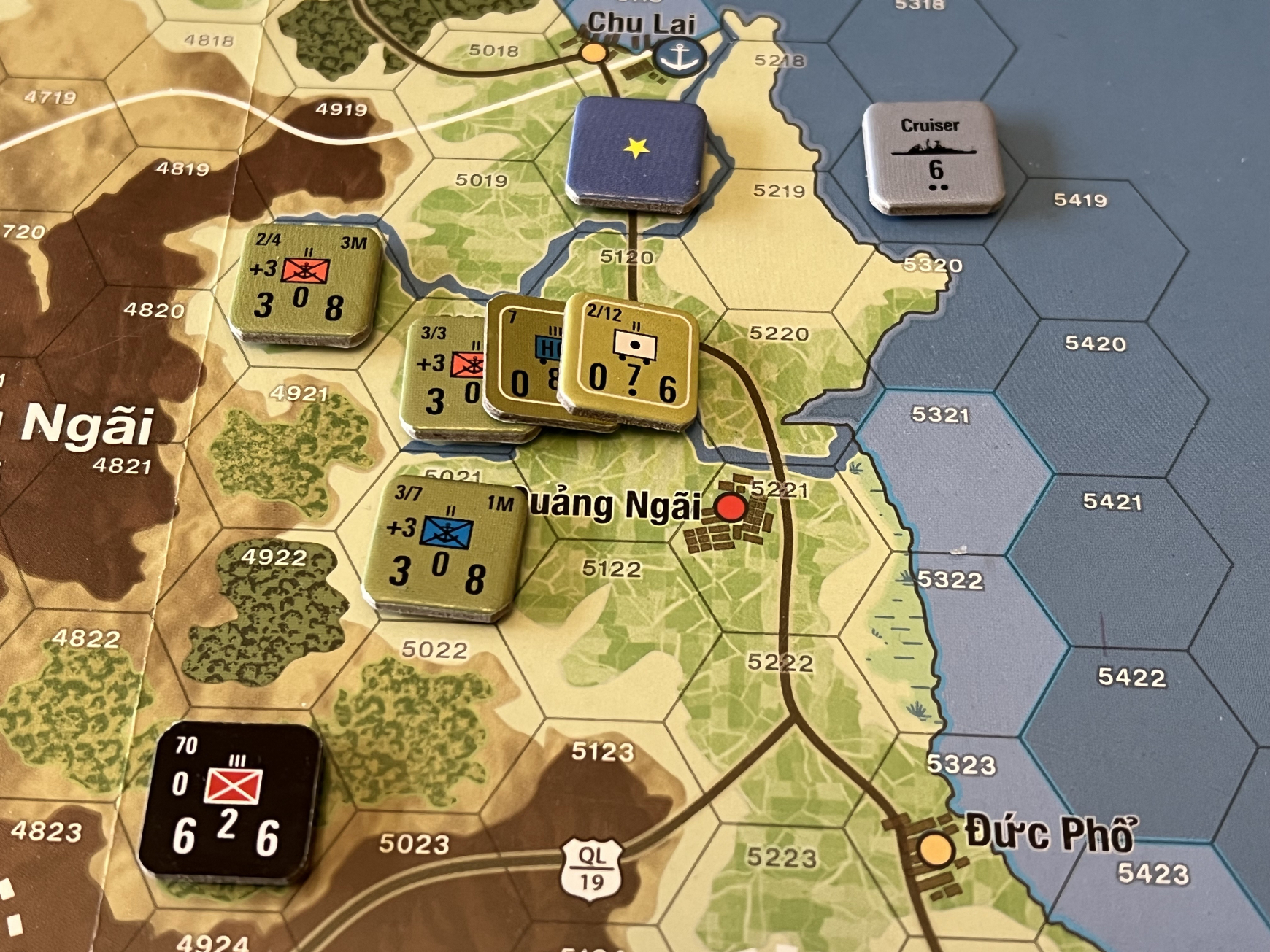Vietnam 1965-1975 5 - Operation Starlite (4)
Tags
NOTE: this game was started April 14, and concluded April 16.
My previous play went so well I thought I’d fire up another one. Because there are so few VC counters in this scenario, it’s super easy to randomize them. When one is flipped, the other is known. I will again attempt this without any recourse to the Playbook worked scenario.
The goal for this game is to get a better grip on how strategy and tactics interact between the FWA and the NLF. Specifically:
- NLF will attempt to evade completely, no offensive combat, and defense only when failing Alert and Reaction rolls.
- FWA, in this case USMC, wants to eliminate VC combat capability.
- FWA needs to find the VC regiment, and put as much
fire support on it as possible. Two keys:
- Finding it.
- Ensuring enough Fire Support.
As a secondary goal, I plan on charting out the Search & Destroy Operation into a bigger, more visual flowchart which I can use for interruptible solitaire playing. To that end I’m resurrecting an old notebook from a seismic review continuing education course from 2004. It’s mostly empty, will be a good use for it.
Turn 1
1. Support Phase
The US player indicates available air, airmobile, and riverine support on his record sheet, placing appropriate markers on the General Record Track.
From the scenario rules:
- US: 4 Airpoints
- US: 1 Airmobile
2. Special Operations Designation Phase
- The US player notes any units on holding or patrol operations.
- The NLF also notes units on holding or patrol operations.
No Special Operations for either faction.
3. Strategic Movement Phase
The US player may conduct security operations and employ strategic and naval movement.
No Strategic Movement this turn.
4. Operations Phase
The heart of the Vietnam 1965-1975 game is the operation. The three main things to remember about operations are:
- The NLF player always determines who performs the next operation, and may choose to pass in favor of the US player performing an operation (Section 5, page 9).
- Each unit may perform only one operation per turn (Section 2.2, page 5).
- Operations proceed as a series of rounds until the US declines is unable to perform further operations. The NLF then decides to either continue operations or end the Operations Phase (Section 5, page 9).
Operations are explained in brief in Section 2.2, page 5, and described in detail in Section 5, page 9 of the rules.
A. Designation Segment
As explained in the preface material in Section 5 (page 9), the NLF always designates who conducts the next operation. The designated player is the phasing player and commences to:
- Choose the type of operation;
- Choose which units participate;
- Specify the target hex of the units (if applicable).
- Operation:
- Units:
- Target Hex:
Operation 1, VC
- Operation: Search & Destroy
- Units: PolSec, 70th Regiment (70R).
- Target Hex: 5220.
Operation 2, USMC
Now I have a decision to make. Should I go all-in on one hex with a 50% chance it’s the 70R. If it is, I can probably win it. If not, it’s a loss. Or should I attempt to reveal the 70R first, then I will know what to do in Operation 3. The risk is that the 70R will succeed on Alert movement, which will be game over and NLF win, almost surely. The NLF loses on Dispersal or Breakdown, so it’s in their interest to stand and fight.
I’m going to replicate the Playbook, and use 3/3/3M to reveal the VC at 5020.
- Operation: Search & Destroy
- Units: 3/3/3M
- Target Hex: 5020.
Operation 3, USMC
Having suffered a severe blow by having 70R nearly escape the battlefield, USMC goes all in for the third operation.
- Operation: Search & Destroy
- Units: 2/4/3M, 2/12, 3/7/1M, 7/1M
- Target Hex: 4921.
B. Support Declaration Segment
The US player may:
- assign air support;
- assign naval support;
- declare free fire zones.
Section 5.1 (page 9) contains details.
Operation 1, VC
N/A.
Operation 2, USMC
Decision time again: USMC could choose to use Naval support for interdiction, in case 70R is revealed, which would make it harder for 70R to succeed at an Alert movement. Let’s follow the Playbook and not declare it here.
Upshot: no support declared.
Operation 3, USMC
- 4 Air points
- 6 Naval, can’t use at the start of the operation, but if a VC retreats into range, will be useful then.
C. Movement Segment
The movement segment applies only during Search & Destroy, Clear & Secure, Security, Naval Transport, or Strategic Movement Operations.
Operating player moves any units assigned to the current operation; may enter ZOCs and Target Hex, may move through enemy hexes (and be subject to Incidental Attacks [4.11]). Airmobile points may be used.
REACTION: At the end of enemy Operating movement, any friendly units in the ZOC and not the Target Hax may move their full movement allowance in Reaction. [4.9]
Operation 1, VC
As I’m playing the VC blind, I do not yet know which unit moved where:
- Unit moves to 5020
- Unit moves to 5120.
The USMC cannot React as its the Target Hex.
Operation 2, USMC
3/3/3M moves to 5020, reveals 70R!
Reaction: PolSec moves to 5019.
Operation 3, USMC
- 3/7/1M: 4921.
- 7/1M: 5020.
- 2/12: 5020.
- 2/4/3M: 4920.
REACTION: VC PolSec to 5119.
D. Alert Segment (only in US operations)
The Alert segment only applies during allied Search & Destroy, Clear & Secure, amd Bombardment Operations. The Operating player may perform Interdiction [7.5.2]; the NLF player may Alert [4.8].
Operation 1, VC
N/A.
Operation 2, USMC
Alert roll: 6!
- roll: 6
- terrain: 1
- scenario: -2
- total: 5
VC moves, spend:
- leave target hex: 2
- enter forested hills: 3
- total: 5.
Need 5, have 5, Alert movement successful. This is really interesting as any other roll than 6 would have pinned the VC. So I need to play this again with the same setup. I think perhaps with an abridged writeup to speed up play.
I suspect this might be the game, as the Cruiser points are lost, so Interdiction would come from other support. Hard to say whether that’s good thing or not, depends on whether it makes a column shift.
Worth noting, during the next Operation, the Alert roll for 70R is going to be +3 for terrain.
NOTE: Had I assigned Naval support, I could have called for Interdiction at this point, and pinned the VC down.
Operation 3, USMC
Alert roll for 70R: 3 + 3 (terrain) for 6 - 2 = 4. Needs: 2 (leave target hex) + 1 to 5021. This may not be a great move, as it is a worse defensive position, but it’s the only move the VC can make. The alternative is staying in the hills, which keeps 2/4/3M in contact for combat.
E. Combat Segment
The Combat segment only applies during Search & Destroy, Clear & Secure, Security, and Bombardment Operations.
Units ending movement in a Target Hex must have combat; units ending movement adjacent to enemy hexes may declare combat. If combat is not declared after movement, the Operation ends immediately. Specifically, Operations without a Target Hex, or when a Target Hex cannot be declared end immediately on conclusion of movement.
INTERDICTION: Either or both players declare interdiction here. [7.5.2]
Operation 1, VC
No combat, this Operation concludes.

Operation 2, USMC
With 1:2 odds, and the VC in advantageous terrain, I’m passing on Combat this Operation, which concludes 3/3/3M’s participation.
Operation 3, USMC
Round 1
- 2/4/3M against VC 70R, odds 1:2, DRM -2.
(Blunder: did not add 1/2 ground support to determine Attack and Defense strengths.)
Roll 3 - 2 for 1:
- VC: 6 + 9 = 15, results, lose 2 REPL.
- USMC: 3 + 2 = 5, results, lose 2. Dang.
Note: full supporting fire up to 3x ground combat strength used for determining losses.
Round 2
2/4/3/M vs 70R, odds 1:2, DRM -2 for odds, -2 for terrain, roll 1 - 4 = 3,
- 70R: 6 + 9 (adding naval support) = 15, lose 1 VC REPL, -4 Pursuit.
- USMC: 3 + 2 = 5, lose 1 US REPL.
F. Retreat Segment
Applies to Security Operations as well. Defending player may move their full Movement Point allowance. If the FWA are non-Operating, they may active Defensive Reserves [6.10.2].
Operation 1, VC
N/A.
Operation 2, USMC
N/A.
Operation 3, USMC
VC retreat to 5022. Can USMC Pursue? Let’s find out.
Round 2, VC retreat to 4923.
G. Pursuit Segment
Operating units may Pursue (FWA and NLF). FWA may activate Offensive Reserves if he is the Operating player [6.10.2].
Operation 1, VC
N/A.
Operation 2, USMC
N/A.
Operation 3, USMC
- 3/7/1M pursues to 5021.
- 2/4/3M, need 2.5 MP to Airmobilize, with -2 Pursuit, can’t do it.
- No other unit can pursue.
Round 2, no pursuit possible so that’s the game.
H. Interdiction Removal Segment
Remove all Interdiction markers from the map.
I. Continuous Operations Combat Segment
Now return to Segment and and repeat until neither player is able or willing to conduct an operation.
Operation 1, VC
N/A.
Operation 2, USMC
N/A.
Operation 3, USMC
Rewind to combat segment and repeat for Round 2.
5. Game Turn Indication Phase
Turn 1 complete and conclusion of scenario.
AAR
VC win.

As it turned out, I did refer to the scenario example playthrough to get some clarity on certain decisions such as declaring support. The example playthrough, however, is not explicit in some places.
Also, I made a blunder on the first combat round: it should have been -4 DRM instead of -2. I forgot to take terrain into account. Round 1 would have been the end of the game.
Another blunder: I did not add the ground support fire when determining combat odds. Given the above blunder with respect to terrain, the outcome probably would have been the same, in this case.
One question: what’s the sequence when moving through a VC Political Section? It has a ZOC, but 0 combat strength. Does it induce Incidental Attack? How would the odds be figured? Could the unit decide to not reveal and not perform Incidental Attacks?